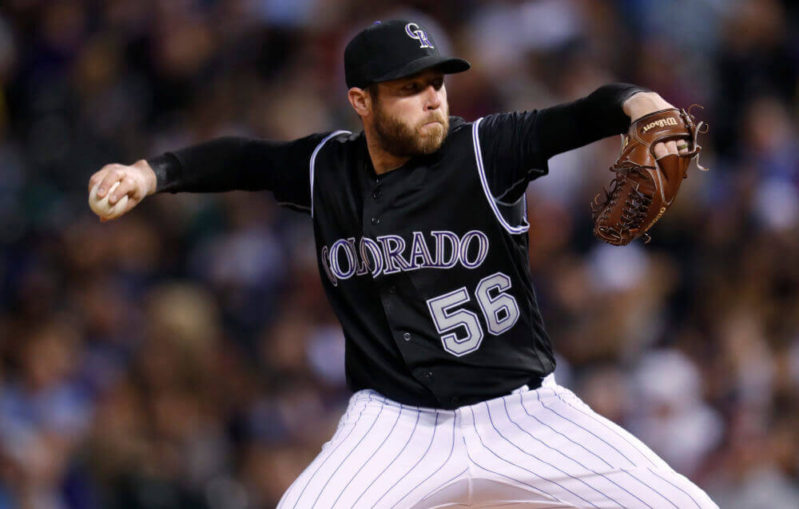
Greg Holland
Position: Reliever/Closer
Bats: Right – Throws: Right
Born: Nov. 20, 1985 (31)
Traditional Stats: 3-6, 3.61 ERA, 61 G, 41 SV, 57.1 IP, 1.151 WHIP, 4.1 BB/9, 11.1 K/9
Advanced Stats: 139 ERA+, 3.72 FIP, 1.4 bWAR, 1.1 fWAR
Before there was Wade Davis, there was Greg Holland dominating out of the back-end of the Royals bullpen. Once he was finally converted to a reliever in 2011, he was as dominating of a bullpen arm as there was in all of baseball. That was especially the case in 2013 and 2014 when he had a combined 1.32 ERA, 0.889 WHIP, and a 13.4 K/9.
He was equally as dominant during that surprising 2014 Royals run to the World Series. In that postseason, he recorded seven saves with a 0.82 ERA, 0.818 WHIP, and a 12.3 K/9.
He struggled to repeat those successes in 2015, and eventually, required Tommy John surgery. As a result, he would not only miss the Royals first World Series championship in 30 years, but the entirety of the 2016 season. Instead of him heading into free agency looking to cash in, he was just looking for the right fit.
Given his previous success, there was a good market for Holland, and ultimately, he decided to bet on himself a bit. He opted to join the Rockies where he was united with his old bullpen coach Steve Foster, who is now the Rockies pitching coach. He signed a one-year, $6 million deal with a $15 million player option for 2017. The deal marked the first and probably last time a pitcher has ever chosen to go to Colorado to rebuild his value.
The surprising thing is that it worked for Holland. According to Brooks Baseball, Holland was throwing a 94 mph fastball with an 87 mph slider that moved about as much as it did in his Kansas City days which led him to have great seasons with the Royals.
He was dominating right out of the gate. In the first half, Holland made 35 appearances going 1-1 with 28 saves, a 1.62 ERA, 1.020 WHIP and an 11.6 K/9. On the strength of that first half, Holland was named an All-Star.
Despite the great first half, there were some warning signs that there would be regression. One of the reasons for his success was a low .235 BABIP against, which is all the more remarkable when you consider he pitches half his game in Coors Field. He was also walking 4.3 batters per nine, which as a closer, is just asking for trouble. Finally, with him not having pitched in a year and a half, he was given a heavy workload.
The breaking point for Holland really came in August when he saw his ERA rise from 1.64 to 3.97 by month’s end. During the month of August, he blew three saves with a 13.50 ERA and a 2.144 WHIP. While he significantly cut down on his walks, it didn’t matter as the opponents BABIP rose from .235 to .333.
Over the final two months, Holland had a 7.38 ERA, 1.368 WHIP and a 9.5 K/9. In that stretch, he was 2-5 and 8/11 in save opportunities. He had similar struggles in the Wild Card game, throwing a wild pitch while allowing two runs on three hits and an intentional walk.
Even with those late season struggles, Holland is once again betting on himself. Instead of exercising his $15 million option, he is going to test the free agent waters once again.
Contract:
It’s still possible the Rockies give Holland a qualifying offer, which is worth $17.4 million. Unlike years past, it is hard to imagine a qualifying offer suppressing Holland’s market as the qualifying offer rules have changed. Generally speaking, instead of forfeiting a first round pick, a team now forfeits its second round pick.
With the second half Holland had, it’s hard to imagine him doing any better than the $15 million option he rejected. That goes double when you consider Kenley Jansen signed a deal last season with an average annual value of $16 million. Realistically speaking, Holland rejected the deal to get a multi-year contract. Likely, said deal is going to be between $10 – $15 million per year.
Recommendation:
If we’re being honest, the Mets are not going to go out there and get Wade Davis or really any top tier reliever. That’s not Sandy Alderson’s MO,and even if he were inclined to change his stripes, the Mets would likely be priced out on those players. Really, if the Mets are going to add that next arm to join Jeurys Familia, AJ Ramos and Jerry Blevins, it’s going to come from the next tier of relievers.
If Holland is available on a two or three-year deal in the vicinity of $12 million per season, the team should look to pull the trigger. Both Familia and Ramos are pending free agents after next year and the team still needs bullpen help beyond them. If Holland demands more years or a bigger payday, his second half should be enough to scare the Mets away and pursue another relief option.















